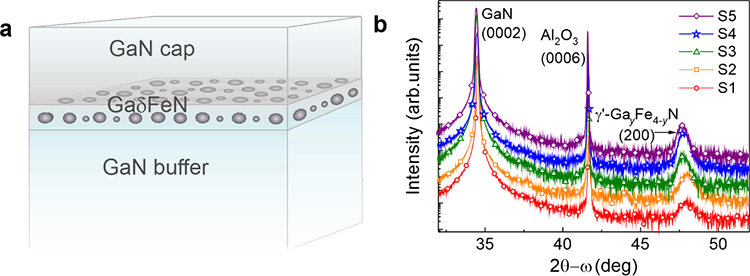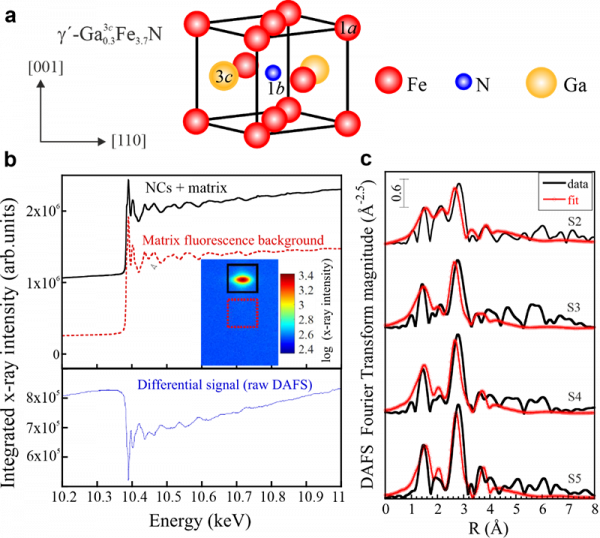Gallium nitride (GaN) and related compounds are key material systems in state-of-the-art opto- and high-frequency-electronic. The spectrum of relevant functionalities is significantly extended through the combination with magnetic elements. For a concentration above 0.4% of Fe cations, (Ga,Fe)N grown via epitaxy undergoes crystallographic phase separation, leading to the formation of Fe-rich embedded nanocrystals (NCs). By fine tuning the growth parameters during the epitaxial process, planar arrays of cubic magnetic GayFe4-yN (0 < y < 1) NCs embedded in the GaN host lattice are stabilized, whose magnetic properties depend on the concentration of Ga in the nanocrystals.
In order to distinguish between the Ga atoms in the NCs and those in the host matrix, an international group of researchers from the Johannes Kepler University, Linz-Austria, the Institute of Physics of the Polish Academy of Science,Warsaw-Poland and the SIRIUS beamline of SOLEIL, have employed a combination of synchrotron anomalous X-ray diffraction and diffraction anomalous fine structure.
The results – published in Scientific Reports – allow to shed light onto the correlation between fabrication parameters, local structural arrangement and overall magnetic properties of the material system.
The investigated samples, sketched in Figure 1a, consist of a GaN capping layer, a phase-separated (Ga,Fe)N layer containing the embedded NCs grown on a 1 μm thick GaN buffer deposited onto a c-plane sapphire (Al2O3) substrate. The size, shape, and density of the cubic GayFe4-yN nanocrystals can be tuned by adjusting the fabrication conditions, making the material suitable for applications in magnetic memory devices and in spin-injection devices.

Figure 1:
a Schematic representation of the (Ga,Fe)N samples containing embedded nanocrystals.
b XRD patterns of the investigated samples, showing a shift of the NCs diffraction peak to larger angles with decreasing Ga content.
The proof of high crystalline quality of the overall samples and the identification of the cubic GayFe4-yN NCs are both obtained from the X-ray diffraction patterns shown in Figure 1b for a series of samples fabricated each with a different Ga content, ranging from 0.07 for S1 to 0.30 for S5. The shift in the (200) NCs diffraction peak to larger angles with decreasing Ga content, indicates an increment in the out-of-plane lattice parameters of the NCs. This increment in the lattice parameter, points at to the incorporation of Ga atoms into the NCs, which have a larger atomic radius than the Fe atoms.

Figure 2:
a Crystal structure of the GayFe4-yN NCs.
b Top panel: Ga K-edge DAFS for sample S5 acquired at the (002) diffraction plane of the NCs including the fluorescence from the matrix (—) and the pure matrix fluorescence signal (- -). Inset: intensity map and regions of interest (ROIs) from which the two spectra are obtained. Bottom panel: differential spectrum obtained from the two spectra shown in the top panel.
c Fourier transform of the DAFS spectra and relative fits.
The local structure of the embedded NCs has been investigated by synchrotron radiation anomalous X-ray diffraction (AXD) and diffraction anomalous fine structure (DAFS) at the SIRIUS beamline of SOLEIL. The experiments have been performed at the Ga K-edge at the (002) diffraction planes of the cubic crystal structure, expected to contain Fe and Ga atoms, as sketched in Figure 2a.
An estimation of the Ga concentration in the samples is obtained from AXD and DAFS by subtracting the Ga-fluorescence background from the measured signal (Figure 2b). The analysis of the relative amplitude of the anomalous effect and the quantitative analysis of the Fourier-transformed extended DAFS spectra shown in Figure2b and c, provide information on the number and position of the Ga atoms in the crystal cell.
The powerful combination of ADX and DAFS, shows that the Ga atoms occupy up to 30% of the positions at the faces of the GayFe4-yN NCs lattice embedded in GaN. The resulting configuration minimizes the Ga-N bond length and the local energy. The magnetic properties of the NCs are not significantly affected by the Ga incorporation, maintaining a ferromagnetic character with Curie temperatures of up to 500 K.
The challenge of distinguishing between the Ga atoms in the host matrix and the ones in the embedded NCs —a task beyond conventional element-sensitive spectroscopies— has been here overcome at the SIRIUS beamline with an approach that can be extended to a large variety of magnetic phase-separated material systems.
